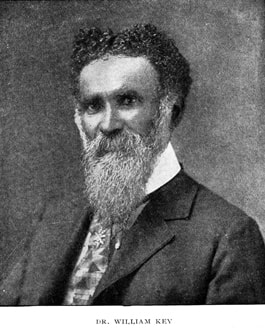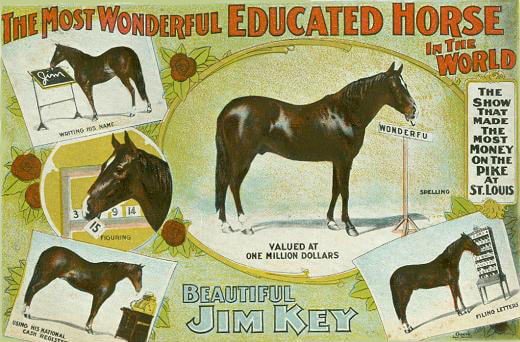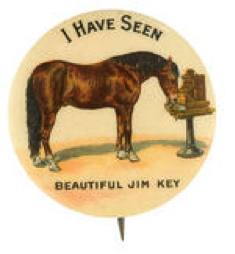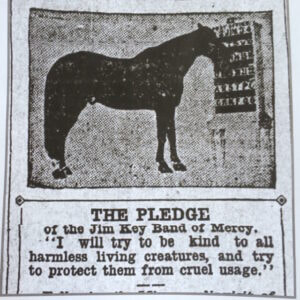 April is Prevention of Cruelty to Animals month. Two of the key players in creating this observation were Dr. William Key and his horse, Beautiful Jim Key. Dr. William Key, who often went by the nickname Bill, was born a slave in 1833 in Murfreesboro, Tennessee. His master, Captain John Key, died when Bill was five. The captain’s will gave Bill and some other slaves to his cousin, John W. Key of Shelbyville, Tennessee. John’s father was disabled and exhibited wild and violent behavior, but it soon became apparent that Bill could calm the old man down. Bill was still quite young when he began showing a special talent for calming recalcitrant horses, too. When the Civil War began, Bill followed John W. Key’s two young sons to Fort Donelson, where he constructed his own shelter, a log-covered dugout known as Fort Bill. He and his two young masters sheltered in the dugout during Union bombardment. When Fort Donelson surrendered, Key helped his masters escape to Confederate forces commanded by Nathan Bedford Forrest. He was later captured and sentenced to hang, but the execution was postponed when Union soldiers discovered he was a good cook and poker player. Key traded his release for forgiveness of the gambling debts of his captors. At the conclusion of the war, all three returned to Shelbyville. Bill, now a free man, opened a hospital for horses on a lot he purchased on North Main Street. His reputation of being able to do wonders for horses caused him to be considered a veterinarian even though he had no formal training as such. In five years, Bill had morphed into Dr. William Key, and was among the most prominent and prosperous individuals in Shelbyville.  Key developed Keystone Liniment, which he promoted with a traveling minstrel and medicine show that used animals to demonstrate his medication’s effectiveness. The liniment was a big enough success that Dr. Key was able to send the two Key boys to Harvard. When asked about this act of kindness and generosity toward his master’s family, he is said to have responded, “I was one of those fortunate men who had a kind master.” Dr. Key then took an interest in racehorses. He decided to breed the fastest horse in the world. Instead of creating a champion, his experiment produced a colt whose legs were so spindly that he was unable to stand for weeks after birth. He named the pitiful little colt Jim, after the town drunk, who had a similarly wobbly gait. As Jim grew, he began showing an unusual intelligence. Beautiful Jim let itself out of gates, opened drawers to retrieve apples, and responded with affirmative and negative nods to questions. Key spent the next seven years training Jim so that he could perform in his traveling minstrel and medicine show. By 1897, the horse could spell, distinguish among coins, make change, write letters and his name on a blackboard, identify playing cards, play a hand organ, and respond to political inquiries.  One of the men to watch Beautiful Jim Key perform was Albert R. Rogers, an officer of the American Humane Association. Impressed that Key used nothing but positive rewards to train his animals, Rogers went into business with Key. For the next nine years, Key, Rogers, a dog named Monk, and Beautiful Jim toured cities across America. Billed as the most educated horse in the world, Beautiful Jim Key became the hottest attraction in the United States. An estimated ten million Americans saw him perform, and others collected his memorabilia – buttons, photos, and postcards – or danced the Beautiful Jim Key two-step.  But more important than entertaining audiences, Key and Rogers changed the way the world looked at animals. During his time touring, hundreds of thousands of children received Jim Key Band of Mercy cards on which they pledged to be kind to animals. Key and Rogers sent sizable shares of their admission sales to local humane societies in the towns they visited. In 1906, after appearing before almost two million spectators, Key and Beautiful Jim retired to Shelbyville, where Key lived comfortably until his death in 1909. Beautiful Jim Key outlived his master by three years, and died in 1912 at the age of 23. A monument to Beautiful Jim Key and “Jim’s Dear Friends” Albert R. Rogers (Promoter), Monk (Pal – the dog) and Dr. William Key (owner and trainer) sits on a low grassy rise three miles south of the Shelbyville Courthouse just north of Himesville Road where it intersects with the Old Tullahoma Highway. This story is part of a series of stories on horses in history.. If you wish to learn more about Beautiful Jim Key, read this early source. Jennifer Bohnhoff writes historical fiction that is suitable for middle grade readers and older. Her novel Code: Elephants on the Moon is set in Normandy, France during World War Two and features Galopin, a Breton horse who helps his owner in the Resistance against the German occupation. Her next book, Where Duty Calls, tells the story of a young man who invades New Mexico with the Confederate Army as he tries to protect his mules. Jennifer Bohnhoff is a Bookshop.org affiliate. If you make a purchase by clicking through the links in this post, she will receive a commission, and Bookshop.org will donate a matching commission to independent booksellers. |






No comments:
Post a Comment